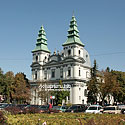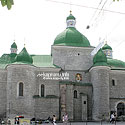Worth seeing in Ternopil
-
Zahrebellya Park
Регіонально-ландшафтний парк відкритий у 1994 р. на протилежному від центру боці Тернопільського ставу. Його площа — 630 га. Він є найбільшим з п'яти тернопольських парків. Тут розташовані дендро- та лісопарк "Кутківці", лісове урочище "Пронятин".
У парку ростуть рідкісні рослини: астранція велика, пальчатокорінник м'ясо-червоний, підсніжник білосніжний, лілія лісова, плавун щитолистий, арум Бессера, глечики жовті, вільха сіра, вовчі ягоди звичайні тощо.
Лише у цьому парку тернополянам та гостям міста дозволено розпалювати багаття.Address: Ternopil -
Cathedral of Blessed Virgin Mary's Immaculate Conception
The Dominican church and monastery were built in 1749-1779 in the late Baroque style. It was designed by A. Moshchynsky. The interior of the church decorated with altars, paintings, sculpture and stone carving has not survived. In 1820-1901 the temple was given to the Jesuits, and the monastery cells housed the gymnasium. After the restoration of 1908-1910 the central dome was changed and the organ was placed.
During the Second World War the church was badly damaged, it was renovated in 1959 and became a storehouse of theatrical scenery. In 1978-1986 it served as the art gallery.
The Cathedral received its present name in 1991, and now it is a 'visiting card' of the city. In the monastery premises the State Archives are located now. In 2004 a monument to Cardinal Yosyp Slipy was erected at the entrance.Address: Ternopil city, Sagaydachny St. 10 -
Church of the Nativity of the Christ
The church is an example of architecture typical for Podillia. It was built during 1602-1608 on the place of a wooden church. Thick walls confirm its defensive character. The Kamenetska gate tower was located just nearby in the XVI c.
In 1709 the second tier was added to the church. And the upper floor began to serve as the Greek-Catholic church of the Holy Trinity, and the lower one became the Orthodox church of the Nativity.
The church got its modern look in 1936-1937. During the restoration of 1956 its dome had been modified. The newest construction of the complex, the Gate tower appeared in 1996.
The church keeps the miraculous icon of Our Lady. A legend says that Bohdan Khmelnytsky prayed in the church during the liberation movement.Address: Ternopil city, Ruska St. 22 -
Feast of the Cross Church
The Temple was built on the place of a wooden church during the period of the XV - early XVI c. It was firstly mentioned in 1570. The church tower that first catches the eye was built in 1627. For several times the church was under restoration. In the Soviet period, for more than 30 years, the church was closed. Part of the authentic icons of the church iconostasis is now displayed in the local museum.
In old times Lviv Gate tower was situated near the church that had a defensive character.Address: Ternopil city, Nad Stavom St. 16 -
Old Park
Оточений вулицями Р. Шухевича, Є. Петрушевича, М. Коцюбинського і розташований біля стадіону.
Закладений у 1861 р. Міський чи Новий парк ("Новий город") став гордістю тернополян. У 1881 р. тут були збудовані швейцарський павільйон, кеглярню й тир, а з часом й оранжерею: у діжках росли такі тропічні рослини, як банани, агави, пальми, кипариси. Вхід на той час був платним. У 1897 р. у парку було встановлено бюст його засновника В. Мандаля, а у 1901 р. відкрито літній театр. У парку відбувалися також різні виставки (бджільнича, городнича, етнографічна тощо). До 300-ліття Бреської унії насипаний пагорб, що став основою для сучасного Пагорбу Слави. Паралельно відбувалася й побудова стадіону, який тоді йменувався, як майдан / оболоня чи просто "На бараках".
Під час Першої та Другої світових воєн парк було зруйновано (у міжвоєнний час відновлювався). Повоєнний парк почали називати Старим, а зі створенням Пагорбу Слави і меморіального комплексу «Вічний вогонь» при нім (1970) — Парком Слави. Від початку незалежності України парк знову перейменовано у Старий.
Загальна площа паркової території — близько 7 га. Тут є близько 40 видів кущів та дерев (тополя біла, бук лісовий, клен ясенолистий, модрина, ялина, ялиця, ялівець, бук, граб, липа, каштан, дуб, ясен), серед яких близько 16 видів екзотичних.
Біля центрального входу стоїть скульптурна група "Мати"/"Материнський поклик" (автори: В. Садовник, К. Сікорський). У південній частині — 3 танки.
Парк включений до природньо-заповідного фонду України.Address: Ternopil -
Park National Revival
Межує з проспектами Злуки, С. Бандери (з цього боку — оглядовий майданчик) та вулиці 15 Квітня.
Площа — 54 га. У парку налічується близько 60-ти видів дерев та кущів. Серед них є каштан кінський, клен ясенелистий, береза пухнаста й бородавчаста, тополі берлінська, канадська й пірамідальна, верби біла, вавилонська й козяча, ялини колюча й звичайна, багряник японський, горіх, різні види й форми туї, ялівцю, спіреї, кипарисовика.
У парку є Співоче поле (1986 р., перше в незалежній Україні), діють атракціони, дитячі та спортивні майданчики, фонтан, а також оглядове колесо (висота — 20 м). Неподалік є гідрологічна пам'ятка природи місцевого значення — «Кузьмовичеві джерела».
У парку розташовані: пам'ятник льотчикам-визволителям м. Тернополя, пам'ятник воїнам-афганцям, пам'ятник чорнобильцям і загиблим міліціонерам, могила Січових стрільців.
Неодмінним атрибутом Дня міста є виставка квітів, народних ремесел, які традиційно відбуваються на горіховій алеї парку.Address: Ternopil -
Taras Shevchenko Park
Розташований біля Тернопільського ставу.
Займає площу 21 га, близько 16 га з якої засадили мешканці міста. Створений на місці заплави Серету, яка щороку навесні та влітку заливалася водою.
У парку було побудовано літню естраду, танцювальний та дитячий майданчики, пляж, фонтани, містки, гойдалки, шахово-шашковий клуб, більярдну, спортивну площадку, торгові кіоски тощо.
На сходах біля Замку красується каскад фонтанів Гронського (названий так на честь його автора). Внизу, у сквері «Підзамче» розміщені скульптури роботи українстких та закордонних митців.
У парку відбуваються різні фестивалі. Є два острови, поширений катамаранний спорт, для любителів веслування, водомоторного і парусного спорту збудовані станції з пристанями, обладнані пляжі. Тут зупиняються мандрівні цирки.Address: Ternopil, Biletska Street -
Ternopil Pond
Можна також почути назву «Тернопільське озеро», хоча це штучна водойма.
Гребля завдовжки 7 км була збудована на річці Серет 1548 р. Утворена водойма виконувала оборонну функцію. У кінці XVII ст. тут існували 4 млини, розводили рибу. На початку ХХ ст. став був приватним.
Найбільшого занепаду водойма зазнала у міжвоєнні часи, у Другу світову війну була повністю знищена. Відновлена у 1950-х рр., на місці пляжу відкрито парк Т. Шевченка.
Тепер ставом з площею 289 га ходить пасажирський катер, а віднедавна ще й автобус-амфібія. Тут є багато риби. Взимку на ставі функціонує ковзанка, проводяться змагання з хокею.Address: Ternopil -
Ternopil's castle
On April 15, 1540 Jan Tarnavskyj, a Cracow magnate, recieved a permission to build a fortress from Sigismund I, a Polish King. Then the construction of the fortress began in Sopilche (Topilche) tract. On three sides the fort was protected by swamps and a pond, and on the side of the city there was a dry moat with an earthen rampart and oak palisade.
Plenty of people found refuge here during the Turkish-Tatar invasions (in 1575, 1589, 1672). The old fortress was rebuilt at the end of the XVII c. In early XIX c. it was rebuilt into a palace, which became the center of cultural life in Ternopil. At that time on the southern side a New Castle was built.
During the Russian rule (1810-1815) there was a casino here, and the city balls were organized.
In 1944 the old castle was destroyed. In 1951 it was reconstructed as the Palace of Sports. The New castle was never reconstructed. Ternopil hotel is located now on its place.Address: Ternopil city, Zamkova St. 12 -
Topilche Park
Побудований на місці болота та торфорозробки і відкритий у 1985 р. як Піонерський. Загальна площа, на якій розміщено алеї, яри для річок та ставків, фонтани, сягає 66 га. Тут є козацьке містечко (на острівцях озера), «космічний» комплекс, аеродром (в минулому — для справжніх літаків та гелікоптерів). Розважальна програма включає атракціони та каруселі, зоокуток. Для дітей цікавими будуть тематичні казкові дерев'яні скульптури. Центральними у парку є водяні млини, які працюють завдяки природньому постачанню води з Тернопільського ставу (гідропарк розташований нижче від рівня озера).Address: Ternopil

 Ukraine
Ukraine Poland
Poland Slovakia
Slovakia
 Українською
Українською








